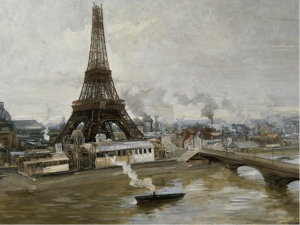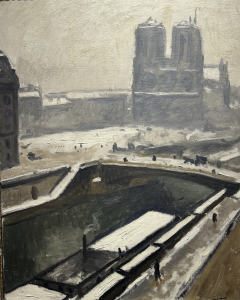Of all the Parisian museums and galleries, the Musée Carnavalet is probably not a first-tier attraction, which is a distinct advantage from the visitor’s perspective. It means one is unlikely to encounter the hordes of selfie addicts that swarm around the Mona Lisa in the Louvre, or Van Gogh’s Self-portrait in the Musée d’Orsay.
The Carnavalet is not a “masterpiece” collection, but a museum dedicated to the history of Paris. It occuppies a suitably historic site in the Marais, combining two large, 16th century mansions. It was the former home of Madame de Sévigné (1626-96), one of the great French women of letters – quite literally, for she is known for her letters to her daughter, first published in 1725, and never subsequently out of print.

Madame de Sévigné is but one of the characters you’ll meet in the Carnavalet, in a narrative that begins in the pre-historic era and continues to the present. We travel through Roman times, the Middle Ages, the Ancien Régime, the Revolutionary and Napoleonic eras, the Second Empire, the Third Republic, and on to the World Wars of the 20th century. The great French kings, from Henri IV, François I, and Louis XIV, are well documented, along with the unfortunate Louis XVI and his Queen, Marie Antoinette. The philosophers of the Enlightenment are present, followed by the turmoil of the French Revolution with its larger-than-life personalities. Inevitably, there’s a huge amount of material on Napoleon Bonaparte.
Among the most fascinating periods is the mid-19th century when Napoleon III tasked Baron Haussmann with a complete make-over of the city. One of Haussmann’s ideas was to create the Musée Carnavalet on its present site, where it opened in 1880.

What’s best about the Carnavalet is that the more French history you absorb, the more you get out of every visit. A little knowledge is fleshed out by a voluminous collection of images and objects. If you don’t know much about the subject, there is no better place to start. It’s a refreshingly old-fashioned museum that relies on material culture to tell a story, with less of those ubiquitous audio-visual distractions that make every contemporary museum seem identical. With more than 620,000 items in the permanent collection, there’s no need to pad out the presentations.
And so, when the Bendigo Art Gallery – the most enterprising regional gallery in Australia – started negotiating for an exhibition from the Carnavalet, there was no shortage of possibilities. The two museums decided, sensibly enough, to confine the show to the years 1880-1925, beginning a decade after the disastrous Franco-Prussian War, when prosperity had returned, and finishing in the year of the famous Art Deco exhibition. Within this span, Paris saw Impressionism evolve from a despised avant-garde tendency to the most collectable art in the world. It was a boom time for the French economy and culture, incorporating that era we know as the Belle Èpoque, which came to a crashing halt in 1914.

The curators of the show, both French and Australian, have chosen to accentuate the “gay paree” angle and not get entangled in events such as the Great War, which would require a show in its own right. The exhibition is divided into seven main sections: Market Town Show, Parisian Public Gardens, The Seine, Universal Exhibitions and the Eiffel Tower, Bohemian Life in Montmartre, Musée Carnavalet, and The Champs-Élysées.
Within each section there is a cluster of paintings, posters, costumes, sculptures, jewellery, objet d’arts, vintage newsreels, and even menus. The eye-catching items in the first room are two large, gilded snails, which once graced the front of a shop in the 1st arrondisement. There are also shoes, hats, advertising posters for department stores, and street decorations used to identify other kinds of merchant.
From commerce we move to leisure, nightlife, Bohemian revels and official celebrations of France’s wealth and power. In those days, even more than today, Paris was the essential destination for those concerned with fashion and art. Most of the Australian artists who went to study in Europe would find their way to Paris, attracted by the private atelier system, whereby students would draw and paint under the tutelage of some petit maître, such as Fernand Cormon or Rodolphe Julian.

Many aspiring artists, such as Charles Conder, were attracted by the free and easy lifestyle Paris offered. The show has a good selection of cabaret posters by Conder’s frequent drinking companion, Henri Toulouse-Lautrec, who may be the most famous artist in this exhibition. Of the many paintings on display, most are by figures who are now considered part of the second division. This doesn’t preclude some stand-outs, such as a beautiful, tonal study of Notre-Dame, by Albert Marquet, that looks as if it were viewed through the studio window of his friend, Henri Matisse, on the Quai Saint-Michel.

There’s a pointillist painting of the Pont des Arts by Paul Signac, and works by Stanislas Lépine, who participated in the first Impressionist exhibition of 1874, but never became a fully-fledged member of the group. His inexhaustible subject was the Seine, which he invariably painted in tones of silvery-grey.
Works tend to be illustrative and topical, which doesn’t preclude the riotous fun of Louis-Abel Truchet’s The Quat-z’Arts cabaret ball (1903), a depiction of a crowded, debauched scene from the annual art students’ ball.

The dominant painter in this selection is Jean Béraud (1849-1935), a witty, dedicated recorder of Parisian life, and a textbook example of ‘le juste milieu’ – that “happy medium” between academic realism and Impressionist flair. The modernity of Béraud’s paintings relies on subject matter, with flat, freely brushed areas suggesting a spontaneity that is no more than a masquerade.
Nevertheless, it’s enjoyable to see a large body of Béraud’s work because he is such a wry observer of the world around him. In The Box by the Stalls (c. 1883), a young woman in a grey dress with an enormous bustle, leans over to adjust her make-up, but her companion can’t take his eyes off the sculptural creation that adorns her rump. Neither can a stranger with a pair of opera glasses, who stands amidst the orchestra, peering into their box.

There’s a similar sexual comedy in Dîner aux Ambassadeurs (c. 1880), where an elegantly dressed young woman is knocking back a glass of red wine, while her male friend, with moustache and top hat, points his cigar towards her like a blowpipe. Already there are two empty bottles on the table in front of them.
Put Béraud alongside Degas or Manet and the nudge-nudge superficiality of his work becomes apparent, but in this show he is a star. Entertaining, though not profound, he is broadly representative of an exhibition that leads us on a superior tourist itinerary through Paris. The dark moments, notably World War One and the Dreyfus Affair, are passed over, in favour of a portrait of the city that emphasises the glitter, the hedonism, the allure of art and fashion. We see all the things that drew people to Paris and established its reputation as ‘capital of the 19th century’, a title coined by German writer, Walter Benjamin. With five Universal Exhibitions between 1855 and 1900, its supremacy remains unchallenged. The Eiffel Tower, created for the Exhibition of 1889, was savagely criticised at the time, but has become the supreme symbol of the city.
Paris – Impressions of Life is precisely what it says – a series of impressions that embrace the romance of Paris without worrying too much about the underlying realities. We see the seductive, upbeat side of history, in which everyday life is engulfed by the myth of a metropolis devoted to pleasure. Balzac portrayed Paris as a place in which the young and ambitious would be gradually robbed of their illusions, but from the tourist’s perspective, one need never stay long enough for the lustre to diminish. One might see Paris as the antidote for the rest of the world: the city above all others that invites us to hold fast to our illusions.
Paris – Impressions of Life 1880-1925
Bendigo Art Gallery, 16 March – 14 July (Bastille Day!)
Published in the Sydney Morning Herald, 27 April, 2024

